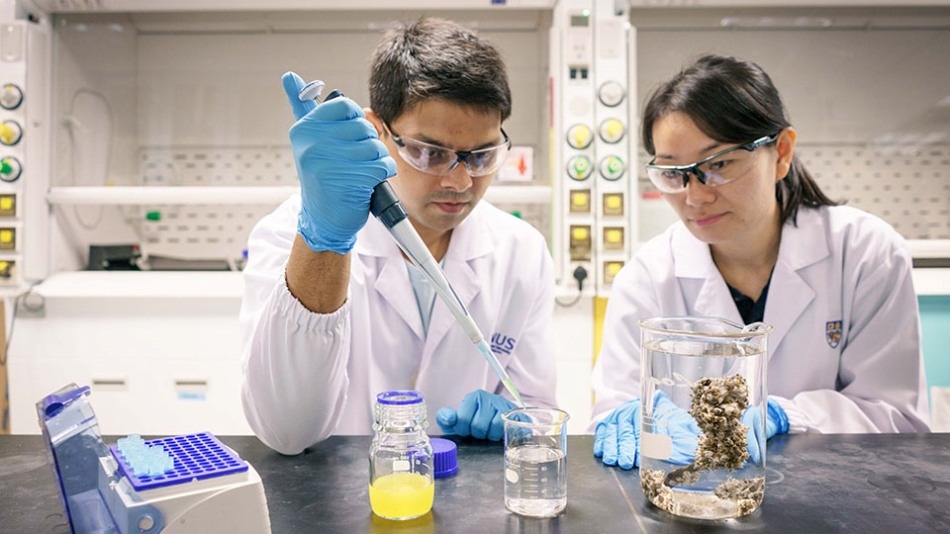Jun 1 2018
According to a new study by researchers from the National University of Singapore (NUS), plastic nanoparticles—minute pieces of plastic that measure less than 1 μm in size—could potentially pollute food chains, and eventually affect human health.
 A research team from the National University of Singapore (NUS) discovered that nanoplastics are easily ingested by barnacle larvae and they can accumulate in the bodies of the larvae over time. Mr Samarth Bhargava (left) and Ms Serina Lee (right) are members of the research team. (Credit: NUS)
A research team from the National University of Singapore (NUS) discovered that nanoplastics are easily ingested by barnacle larvae and they can accumulate in the bodies of the larvae over time. Mr Samarth Bhargava (left) and Ms Serina Lee (right) are members of the research team. (Credit: NUS)
They learned that nanoplastics are easily ingested by oceanic organisms, and they collect in the organisms over time, with a risk of being moved up the food chain, threatening food safety, and posing health hazards.
Ocean plastic pollution is a massive and growing problem worldwide. It is projected that the oceans may already contain more than 150 million ton of plastic, and annually, around eight million tons of plastic will find its way into the ocean. Plastics are not easily degradable. In the aquatic environment, plastics are typically broken down into smaller pieces by the waves, sun, microbial. and wind action. These micro- and nanoplastic particles in the water may be consumed by filter-feeding marine organisms such as tube worms, barnacles, and sea-squirts.
Taking the acorn barnacle Amphibalanus amphitrite as a model organism, the NUS team established for the first time that nanoplastics ingested during the larval stage are retained and collected inside the barnacle larvae until they touch adulthood.
We opted to study acorn barnacles as their short life cycle and transparent bodies made it easy to track and visualise the movement of nanoplastics in their bodies within a short span of time.”
Samarth Bhargava, First Author
Barnacles can be found in all of the world’s oceans. This accumulation of nanoplastics within the barnacles is of concern. Further work is needed to better understand how they may contribute to longer term effects on marine ecosystems.”
Dr. Serena Teo, Co-Supervisor
Studying the fate of nanoplastics in marine organisms
The researchers incubated the barnacle larvae in solutions of their regular feed joined with plastics that are around 200 nm in size having green fluorescent tags. The larvae were exposed to two varied treatments: ‘chronic’ and ‘acute’.
In the ‘acute’ treatment, the barnacle larvae were kept for three hours in a solution that had 25 times more nanoplastics than latest estimates of what is present in the oceans. Oppositely, under the ‘chronic’ treatment, the barnacle larvae were exposed to a solution comprising low concentrations of nanoplastics for up to four days.
The larvae were then strained from the solution and analyzed under the microscope. The movement and distribution of the nanoplastics were observed by analyzing the fluorescence from the particles present in the larvae over time.
Our results showed that after exposing the barnacle larvae to nanoplastics in both treatments, the larvae had not only ingested the plastic particles, but the tiny particles were found to be distributed throughout the bodies of the larvae.”
Serina Lee, The Tropical Marine Science Institute at NUS
Despite the fact the barnacles’ innate waste removal pathways of molting and excretion brought about some removal of the nanoplastics, the team detected the persistent presence of nanoplastics inside the barnacles during the course of their growth until they touched adulthood.
The team’s study findings were first published online in the journal ACS Sustainable Chemistry & Engineering in March 2018. The research was sponsored under the Marine Science Research and Development Program of the National Research Foundation Singapore.
Next steps
The NUS research team aim to expand their understanding of the translocation of nanoparticles within the marine organisms and possible pathways of transfer in the marine ecosystem.
The lifespan and fate of plastic waste materials in marine environment is a big concern at the moment owing to the large amounts of plastic waste and its potential impact on marine ecosystem and food security around the world. The team would like to explore such topics in the near future and possibly to come up with pathways to address such problems.”
Associate Professor Suresh Valiyaveettil, Co-Supervisor
The team is presently analyzing how nanoplastics impact other invertebrate model organisms to comprehend the effect of plastics on marine ecosystems.